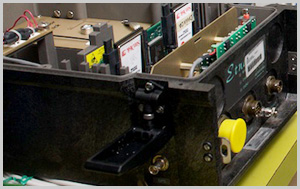
![]()
Seismic Instrumentation
 __________________________________________________________________________________
__________________________________________________________________________________
The Seismic Instrumentation Department is part of the Structures and Geotechnics Head Office and was created in order to study and understand seismic events. It was considered essential to have an adequate measurement and monitoring infrastructure to allow, from the records obtained, the definition of the rupture area, the occurrence and intensities that the soils and structures are subjected to, so that these are reflected in the design recommendations thus resulting in building safer structures.
In the sixties, there was a surge of accelerographic instrumentation or strong tremors. Since then, there has been a sustained effort to improve the coverage of seismic observation in the country to such a degree that, without doubt, it has now the most important infrastructure for this purpose in Mexico.
In recent years, the Ministry of Interior and the UNAM signed, for an indefinite term, an agreement of cooperation on civil protection. For this purpose, it was established the implementation of the project called Mexican Seismic Network (MSN),whose main objective is to strengthen and modernize earthquake monitoring infrastructure available in the country and integrate it through an information and data processing system in real time.
Having this infrastructure with real-time communication has allowed, after an earthquake occurs, for the development of seismic intensity maps at both the national level and the Valley of Mexico, assessing the severity of the earthquake in order to assist the authorities of civil protection for emergency actions.
The accelerographic network currently consists of 110 of so-called free field stations ranging along the Pacific coast from Nayarit to Tapachula, as well as instruments installed in structures such as buildings, bridges, monuments, landfills, pyramids and viaducts. This has allowed for the gathering of valuable information for studying the effects of site and soils effects, and to study the behavior of structures.
The department is composed of 17 academic technicians and a variable number of social service providers and research assistants. Their greatest strength is due to the multidisciplinary coordination of applied mechanics, structures, geotechnical and seismic engineering.